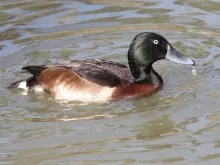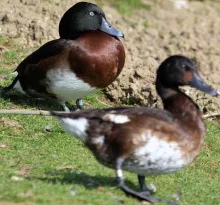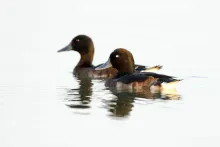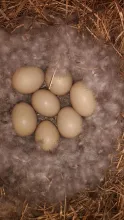
Baer's Pochard (Aythya baeri)
Species name
- Dutch name:
- Baers witoogeend
- English name:
- Baer's Pochard
- German name:
- Baerente
- French name:
- Fuligule de Baer
- Scientific name:
- Aythya baeri
Scientific classification
- Order:
- Anseriformes
- Family:
- Anatidae
- Onderfamilie:
- Aythyinae
- Genus:
- Aythya
Description
- Description:
Male:
The male has a green shiny head, a brown breast, a dark gray back and brown flanks, after which the white belly reaches out streaky. The beak is blue-gray and gets a little lighter in front of the black nail. The iris is straw yellow to white. In the resting dress, the black-brown head and neck game is lackluster in the drake. The trunk plumage is dull gray-brown. The flanks also have darkened and the beak coloration assumes a darker blue gray. The iris is also in the rest dress unchanged straw yellow to white.Female:
The female is of a greyish brown color and has no noticeable differences in feathering compared to other duck female females. It can be distinguished, above all, on the basis of the size and the clunky acting beak of other bog ducks. Her beak is dark gray. The iris is dark brown.Juvenile:
Young bearers are similar to the female regardless of gender. Her dark brown head and torso plumage is lackluster. The bright belly sides are still densely interspersed with gray-brown feathers. The flanks are lighter only in the lower part.
Standard Measurements
- Body Length (cm):
- The male (drake) of the Baer's Pochard measures approximately 41-46 centimeters. The female measures approximately 41-46 centimeters.
- Body Weight (grams):
- The male will weight about 880 gram. The female will weight about 680 gram.
The weight is notoriously variable and can only be used as indication!
- Note:
Pochards are diving ducks which spend most of their time on water, and are ungainly on land. They are generally hardy, sociable and easy to maintain in captivity. They should be kept with deep water available for diving, three to seven feet suggested, or at least half the area 60cm and preferably one metre deep, with shallow sloping banks for easy exit from the water, also islands, good marginal vegetation and loafing areas. Water providing a good supply of natural animal and vegetable food is preferred.
These ducks may be kept in mixed collections with dabbling ducks, including smaller species such as teal. They should be fed floating pellets in water, encouraging their natural diving behaviour. They may breed better if a group rather than single pair kept, as this allows their normal group displaying activity.
The Baer's Pochard prefer as breeding area lakes in a flat, vegetation-rich terrain. They are relatively easy to keep and breed, nesting in close ground cover or in ground-level nest boxes. Eggs are usually laid April to June.
Nest box size 30x30x35cm with 12.5cm entrance hole suggested, placed under cover at the edge of the pond.
- Breeding:
- The female Baer's Pochard usually lays from 6-10 cream, yellowish-grey or pale brown eggs and incubates them for 27 days.
- Artificial incubating:
The ideal relative humidity for incubating most waterfowl eggs is 55% (ground nesters) and 40% (cavity nesters). The temperature is usually 37.4°C. Set ventilation as recommended by the incubator manufacturer. Eggs must be turned, either automatically or by hand, a minimum of 4 times a day. As the duckling develops there is a loss of water from the egg and the air sac gets bigger. In normal development of an egg with a 27 days incubation, the air sac occupies about a third of it three days earlier. Cleanliness is vital and ideally eggs should be moved to a separate hatcher at this point, where the humidity should be increased to 65% and even higher once they have pipped internally.
- Bird banding:
- Recommended closed leg band ring size for the Baer's Pochard is 10 mm.The leg band ring can only be applied on a young diving duck at around 12 days old.
- It doesn't matter what leg that you band, but it's good to have a consistent system. Suggested: Left leg = Female, Right leg = Male
- Rearingfeed:
-
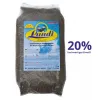
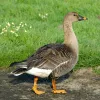

Floatable special rearing feed for all types of aquatic ornamental fowl - especially for the cultivation of trees as well as greening ducks.
This well-balanced complete feed with 20% protein content convinces above all by its good compatibility and forms the basis for visibly healthy growth from day one.
Made exclusively from wholesome and selected raw materials, Lundi Micro Regular is also ideally suited for the year-round feeding of waterfowl.
- Maintenance food:
-



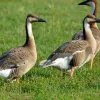

Lundi Regular with a protein content of 20%, valuable Spirulina and high-quality by-products is optimally balanced in its composition maintenance food for water ornamental fowl of all kinds. Especially green teal and Whistling ducks that are not dependent on a very high protein content, are well supplied.
Lundi Regular contains all the minerals and vitamins in full form that are important for the animals. Therefore also suitable as breeding food.


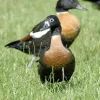


Floating full food for all sea ducks, green ducks, eider ducks and geese, especially in the moulting and breeding phase ideally suited. Packed with wholesome raw materials, natural vitamins and trace elements, this performance food with a protein content of 30% forms the basis for lifelong vitality.
